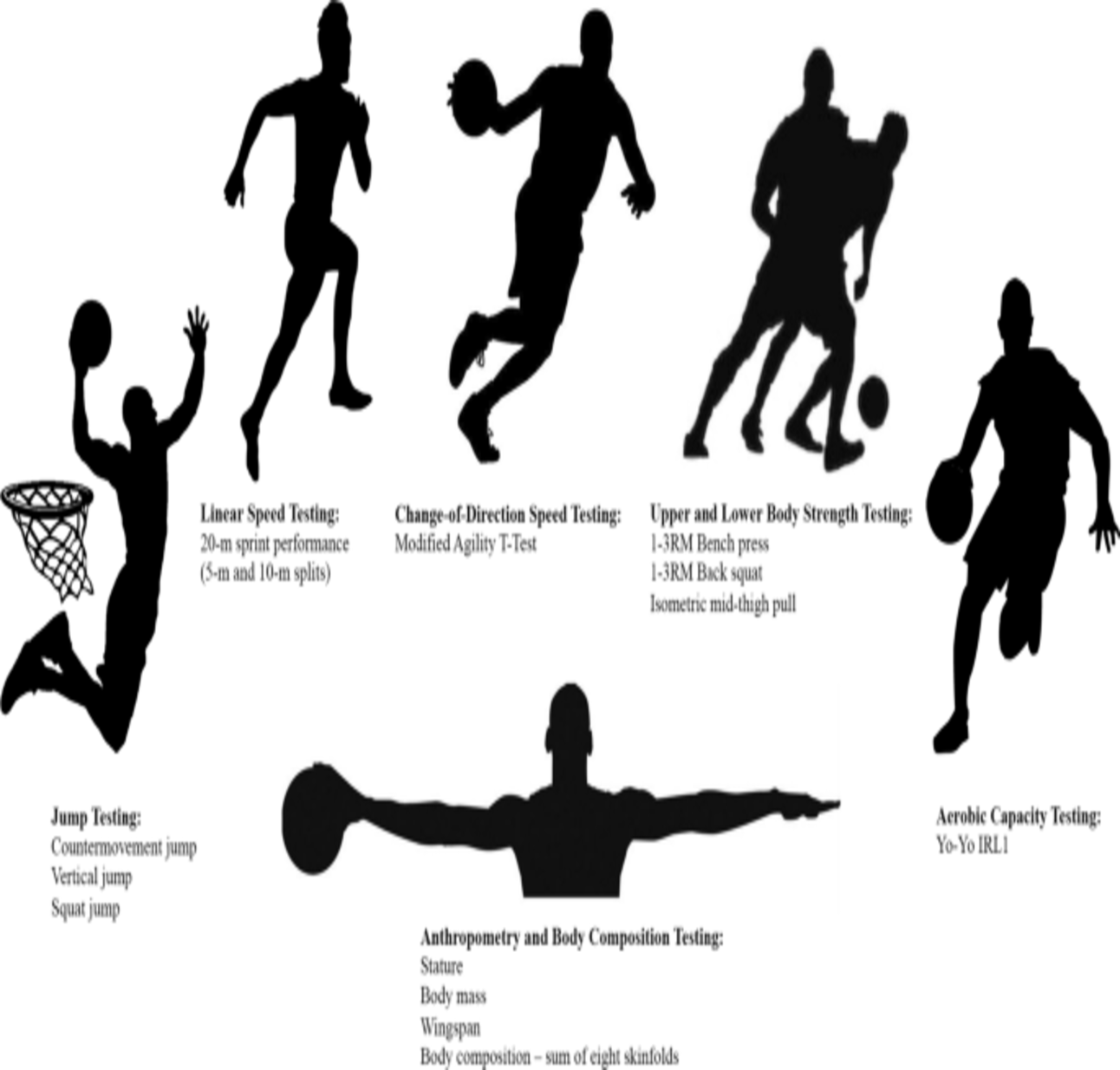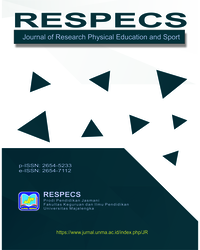PHYSIOLOGICAL PROFILE OF SPEED, AGILITY AND JUMPING ABILITY OF ELITE U16 BASKETBALL PLAYERS
DOI:
https://doi.org/10.31949/ijobs.v1i2.3879Abstract
The purpose of the study was to record the physiological profile of the U16 elite men basketball players of national teams per playing position as well as to compare the differences of those physiological profiles between the playing positions. The study involved 17 young male basketball players (average weight 84 kg, average height 1.97 cm, average age 15.9 years). Players were classified according to their positions in Guards (G: n = 7), Forwards (F: n = 6), and Centers (C: n = 4). In order to determine the physiological profile of the elite players of the study, tests were performed which were divided into 3 characteristics: speed (5m-10m Sprint), agility (T-drill) and jumping ability / anaerobic power (CMJ, DJ, SJ). In the inductive analysis, the possible differences between the different positions of the players were examined through the one-way ANOVA tests. The main findings suggest that the physiological profile of speed, agility and jumping ability of the U16 male players of the Greek National Basketball Team is at a high level. Specifically, the Guards recorded an average of jump height 41.73 cm for the 3 trials (CMJ, SJ, DJ) and times 0.73 ± 0.03 (s), 1.87 ± 0.04 (s) for the 5m. and 10m. sprints and 8.39 ± 0.23 (s) for the T-drill test. Respectively, the Forwards of the research recorded average jump heights of 40.12 cm for the 3 trials (CMJ, SJ, DJ) and times 0.75 ± 0.07 (s), 1.93 ± 0.12 (s) for the 5m, and 10m sprints, and 8.48 ± 0.47 for the T-drill test. Finally, the Centers recorded an average of jump height 42.82 cm for the 3 trials (CMJ, SJ, DJ) and times 0.74 ± 0.05 (s), 1.89 ± 0.04 (s) for the 5m. and 10m. sprints and 8.48 ± 0.31 (s) for the T-drill test. The findings showed that there were no differences between the 3-position players in the 5m / 10m speed tests as well as in the T-drill agility test. On the other hand, in the jump tests, paradoxically, the elite U16 players from the Centers position had the best performance in general in the 3 jump tests and in particular in the CMJ and SJ and the Guards players had the best performance in the DJ. The Forwards position players had the worst performance in all 3 jump tests.
Keywords:
physiological profile, national team, speed, agility, jumping capacityDownloads
References
Altavilla, G., D’Isanto, T., & Di Tore, P. A. (2018). Anthropometrics characteristics and jumping ability in basketball. Journal of Human Sport and Exercise - 2018 - Spring Conferences of Sports Science. Journal of Human Sport and Exercise - 2018 - Spring Conferences of Sports Science. https://doi.org/10.14198/jhse.2018.13.Proc2.22
Arede, J., Fernandes, J., Moran, J., Norris, J., & Leite, N. (2021). Maturity timing and performance in a youth national basketball team: Do early-maturing players dominate? International Journal of Sports Science & Coaching, 16(3), 722–730. https://doi.org/10.1177/1747954120980712
Bal, B. S., Kaur, P. J., & Singh, D. (2011). EFFECTS OF A SHORT TERM PLYOMETRIC TRAINING PROGRAM OF AGILITY IN YOUNG BASKETBALL PLAYERS. 5(4), 9.
Ben Abdelkrim, N., Castagna, C., Jabri, I., Battikh, T., El Fazaa, S., & Ati, J. E. (2010). Activity Profile and Physiological Requirements of Junior Elite Basketball Players in Relation to Aerobic-Anaerobic Fitness. Journal of Strength and Conditioning Research, 24(9), 2330–2342. https://doi.org/10.1519/JSC.0b013e3181e381c1
Boone, J., & Bourgois, J. (2013). Morphological and Physiological Profile of Elite Basketball Players in Belgium. International Journal of Sports Physiology and Performance, 8(6), 630–638. https://doi.org/10.1123/ijspp.8.6.630
Cui, Y., Liu, F., Bao, D., Liu, H., Zhang, S., & Gómez, M.-Á. (2019). Key Anthropometric and Physical Determinants for Different Playing Positions During National Basketball Association Draft Combine Test. Frontiers in Psychology, 10, 2359. https://doi.org/10.3389/fpsyg.2019.02359
Delextrat, A., & Cohen, D. (2008). Physiological Testing of Basketball Players: Toward a Standard Evaluation of Anaerobic Fitness. Journal of Strength and Conditioning Research, 22(4), 1066–1072. https://doi.org/10.1519/JSC.0b013e3181739d9b
Ferioli, D., Rampinini, E., Bosio, A., La Torre, A., Azzolini, M., & Coutts, A. J. (2018). The physical profile of adult male basketball players: Differences between competitive levels and playing positions. Journal of Sports Sciences, 36(22), 2567–2574. https://doi.org/10.1080/02640414.2018.1469241
García, F., Vázquez-Guerrero, J., Castellano, J., Casals, M., & Schelling, X. (2020). Differences in Physical Demands between Game Quarters and Playing Positions on Professional Basketball Players during Official Competition. 8.
Gómez-Carmona, C. D., Mancha-Triguero, D., Pino-Ortega, J., & Ibáñez, S. J. (2021). Exploring Physical Fitness Profile of Male and Female Semiprofessional Basketball Players through Principal Component Analysis—A Case Study. Journal of Functional Morphology and Kinesiology, 6(3), 67. https://doi.org/10.3390/jfmk6030067
Gonzalo-Skok, O., Serna, J., Rhea, M. R., & Marín, P. J. (2017). AGE DIFFERENCES IN MEASURES OF FUNCTIONAL MOVEMENT AND PERFORMANCE IN HIGHLY TRAINED YOUTH BASKETBALL PLAYERS. 10.
Hůlka, K., Cuberek, R., & Bělka, J. (2013). Heart rate and time-motion analyses in top junior players during basketball matches. Acta Gymnica, 43(3), 27–35. https://doi.org/10.5507/ag.2013.015
İMer, M., & Yapici, A. (2018). THE COMPARISON OF PHYSIOLOGICAL AND MOTORIC CHARACTERISTICS OF U16-U18 BASKETBALL PLAYERS ACCORDING TO THEIR PLAYING POSITIONS. The Online Journal of Recreation and Sport, Volume 6(Volume 6 Issue 4), 94–100. https://doi.org/10.22282/ojrs.2017.24
Kryeziu, A., Begu, B., Asllani, I., & Iseni, A. (2019). Effects of the 4 week plyometric training program on explosive strength and agility for basketball players. Turkish Journal of Kinesiology. https://doi.org/10.31459/turkjkin.553453
Lockie, R. G., Beljic, A., Ducheny, S. C., & Dawes, J. J. (2020). Relationships between Playing Time and Selected NBA Combine Test Performance in Division I Mid-Major Basketball Players. 14.
Mancha-Triguero, D., García-Rubio, J., Gamonales, J. M., & Ibáñez, S. J. (2021). Strength and Speed Profiles Based on Age and Sex Differences in Young Basketball Players. International Journal of Environmental Research and Public Health, 18(2), 643. https://doi.org/10.3390/ijerph18020643
Morrison, M., Martin, D. T., Talpey, S., Scanlan, A. T., Delaney, J., Halson, S. L., & Weakley, J. (2022). A Systematic Review on Fitness Testing in Adult Male Basketball Players: Tests Adopted, Characteristics Reported and Recommendations for Practice. Sports Medicine. https://doi.org/10.1007/s40279-021-01626-3
Orhan, O., Polat, S. C., & Yarim, I. (2019). Relationship Between Jump Performance and Sport Ages in U16 Basketball Players. Journal of Education and Learning, 8(2), 207. https://doi.org/10.5539/jel.v8n2p207
Pion, J., Segers, V., Stautemas, J., Boone, J., Lenoir, M., & Bourgois, J. G. (2018). Position-specific performance profiles, using predictive classification models in senior basketball. International Journal of Sports Science & Coaching, 13(6), 1072–1080. https://doi.org/10.1177/1747954118765054
Roni Gottlieb, Shalom, A., & Calleja-Gonzalez, J. (2021). Physiology of basketball – field tests. Review article. 9.
Sallet, P., Perrier, D., Ferret, J. M., Vitelli, V., & Baverel, G. (2005). PHYSIOLOGICAL DIFFERENCES IN PROFESSIONAL BASKETBALL PLAYERS AS A FUNCTION OF PLAYING POSITION AND LEVEL OF PLAY. 14.
Scanlan, A., Dascombe, B., & Reaburn, P. (2011). A comparison of the activity demands of elite and sub-elite Australian men’s basketball competition. Journal of Sports Sciences, 29(11), 1153–1160. https://doi.org/10.1080/02640414.2011.582509
Scanlan, A. T., Tucker, P. S., & Dalbo, V. J. (2014). A Comparison of Linear Speed, Closed-Skill Agility, and Open-Skill Agility Qualities Between Backcourt and Frontcourt Adult Semiprofessional Male Basketball Players. Journal of Strength and Conditioning Research, 28(5), 1319–1327. https://doi.org/10.1519/JSC.0000000000000276
Shalfawi, S. A., Sabbah, A., Kailani, G., Tønnessen, E., & Enoksen, E. (2011). The Relationship Between Running Speed and Measures of Vertical Jump in Professional Basketball Players: A Field-Test Approach. Journal of Strength and Conditioning Research, 25(11), 3088–3092. https://doi.org/10.1519/JSC.0b013e318212db0e
Sudhakar, S., Kumar, G. M., Ramanathan, K., & Vasanth, P. (2016). EFFICACY OF 6 WEEK PLYOMETRIC TRAINING ON AGILITY PERFORMANCE IN COLLEGIATE MALE BASKETBALL PLAYERS. 8.
te Wierike, S. C. M., Elferink-Gemser, M. T., Tromp, E. J. Y., Vaeyens, R., & Visscher, C. (2015). Role of maturity timing in selection procedures and in the specialisation of playing positions in youth basketball. Journal of Sports Sciences, 33(4), 337–345. https://doi.org/10.1080/02640414.2014.942684
Torres-Unda, J., Zarrazquin, I., Gil, J., Ruiz, F., Irazusta, A., Kortajarena, M., Seco, J., & Irazusta, J. (2013). Anthropometric, physiological and maturational characteristics in selected elite and non-elite male adolescent basketball players. Journal of Sports Sciences, 31(2), 196–203. https://doi.org/10.1080/02640414.2012.725133
Trunić, N., & Mladenović, M. (n.d.). THE IMPORTANCE OF SELECTION IN BASKETBALL. 14.
Vázquez-Guerrero, J., Jones, B., Fernández-Valdés, B., Moras, G., Reche, X., & Sampaio, J. (2019). Physical demands of elite basketball during an official U18 international tournament. Journal of Sports Sciences, 37(22), 2530–2537. https://doi.org/10.1080/02640414.2019.1647033
Vikesh Kumar. (2016). Comparative study of physical and physiological profile of basketball and handball players. International Journal of Physiology, Nutrition and Physical Education.


.png)

